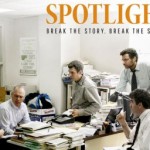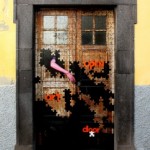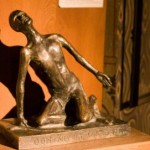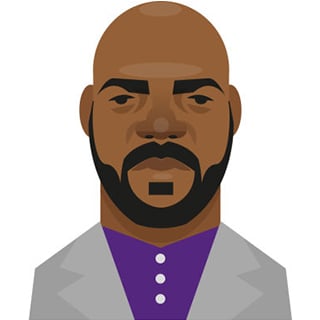 Doubting Thomas – he’s always featured on the Sunday after Easter. He’s reliable. He anchors the season and relieves the atmosphere, which is always over-lily-ed. And who can’t relate to him?
Doubting Thomas – he’s always featured on the Sunday after Easter. He’s reliable. He anchors the season and relieves the atmosphere, which is always over-lily-ed. And who can’t relate to him?
His name means ‘twin’ in Greek. The twin, nestled next to him in spirit, is us. Across the centuries our connection to him is immediate. His tone, his stance, the look in his eyes as he makes his remarks, are ours. We doubt what he doubts: Easter.
The truth is, Doubting Thomas is present in most church pews on Easter Day. He’s there because he loves a true believer. Or, he’s there because he likes the place, the people, even though his questions remain unanswered. Or perhaps he’s there because, on Easter, he buys his mother a corsage and takes her to church and out to lunch, then returns to his real world. Or he’s there as one who used to believe, but too many terrible things have happened over the years, the death of a child, or divorce, or cancer, and he just doesn’t believe in Easter now. Like a teenager forced to put on a suit, he endures the trappings of this day, but he is not persuaded by trumpets, fanfare, extra anthems and memorial flowers, that resurrection is real. He is waiting to get out of here.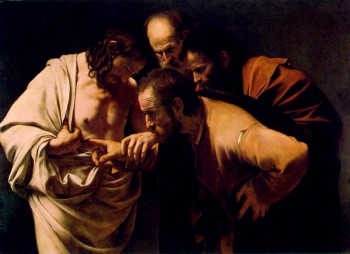
The gospel stories include other doubters, and make some distinctions between the spirit of our doubting. Thomas’ doubt is the stubborn kind, the kind of doubt that is rooted in suspicion – and perhaps in clinging to sorrow. Thomas has been as broken-hearted as the others by all that has happened, but it is harder for him to let his sorrow go. He’s a Missouri kind of guy, and he wasn’t there when Jesus appeared to the others. For him this is second-hand news, and what seems impossible to him will not be made possible by a tall tale, told by hid friends, whom he has never thought infallible.
 Luke tells a different story of Doubters, a story about the disciples a few days after Easter seeing Jesus in their upper room, and, Luke says, they were disbelieving in joy and still wondering . . . . So doubt can be ours in a less suspicious form, in a spirit more willing to be persuaded that inexplicable experience can be real. Doubt can even be ours in believing, according to Luke. And we can still be wondering as we move on, for the journey into a changed understanding does not happen like a thunderclap, it really is an experience of walking away from Egypt, carrying our doubts like unrisen bread, to keep us alive along the way. These doubts do not have a deep root of suspicion, these doubts seek knowledge and will accept experience, and even joy, with an open heart.
Luke tells a different story of Doubters, a story about the disciples a few days after Easter seeing Jesus in their upper room, and, Luke says, they were disbelieving in joy and still wondering . . . . So doubt can be ours in a less suspicious form, in a spirit more willing to be persuaded that inexplicable experience can be real. Doubt can even be ours in believing, according to Luke. And we can still be wondering as we move on, for the journey into a changed understanding does not happen like a thunderclap, it really is an experience of walking away from Egypt, carrying our doubts like unrisen bread, to keep us alive along the way. These doubts do not have a deep root of suspicion, these doubts seek knowledge and will accept experience, and even joy, with an open heart.
There’s a third Doubter, whose story is told in Mark 9: he’s the father of a boy who suffers frequent convulsions. He has brought his son to the disciples, in hope of healing, but they have not been able to help. Jesus arrives and asks what is happening here. The father tells about his son, saying sometimes the boy falls in the fire, sometimes in water and nearly drowns. Can you help him? he asks. And Jesus questions the question, calling it doubt, and asking for faith. And the father replies, Lord I believe; help my unbelief.
Jesus commands the convulsing spirit to leave the boy and it does. At first the boy appears dead, but then he is able to stand. It’s not a glorious moment, but it does seem to be freedom.  Later the disciples ask why they couldn’t do it. And rather enigmatically, Jesus replies, This kind can only be handled with prayer. Since Jesus quite specifically did not pray over the boy, he commanded, as the disciples had done (but without success), where is the prayer?
Later the disciples ask why they couldn’t do it. And rather enigmatically, Jesus replies, This kind can only be handled with prayer. Since Jesus quite specifically did not pray over the boy, he commanded, as the disciples had done (but without success), where is the prayer?
It is in the mouth of the father. The father, who prayed, Lord, I believe, help my unbelief. The father has to offer, on his child’s behalf, a heart full of hope, hope for the child as the child is now, rather than doubt about the life of the child – or the goodness of God – or the goodness of life itself – or of his own life, as the father. Not, I think, doubt in Jesus – the father was begging Jesus, but he was begging without hope, in himself or in his child, that God was with them in their scary and unpredictable life.
We hold our doubt in so many spirits, stubborn, truculent, weepy, stalwart, suspicious, wily, crippling, demanding, exhausted. Easter belongs to us when we are able, even in doubt, to honor the grace of our lives, and even find joy. Death is a very hard reality to disbelieve. Yet, death is the harshness in which hope seeks openings, for doubt that can welcome signs of life, and for joy in our love.
We owe Doubting Thomas our deep thanks. For Doubting Thomas pipes up. And because of him, Easter can be seen even through our doubts, and continues in our presence, as he does. _____________________________________________________ Illustrations:
1. The Incredulity of Thomas. Duccio, di Buoninsegna, 1308. Museo-dell’Opera-del-Duomo-Siena-Italy. Vanderbilt Divinity School Library, Art in the Christian Tradition.
2. The Incredulity of St. Thomas. Caravagio, Michelangelo. 1601. Neues Palais in Sansoucie, Potsdam, Germany. Vanderbilt Divinity School Library, Art in the Christian Tradition.
3. Endless Road. Margaret Hofheiz-Doring, 1971. Vanderbilt Divinity School Library, Art in the Christian Tradition.
4. This is Where I Find My Peace. 2008. Houston Texas. Vanderbilt Divinity School Library, Art in the Christian Tradition.


